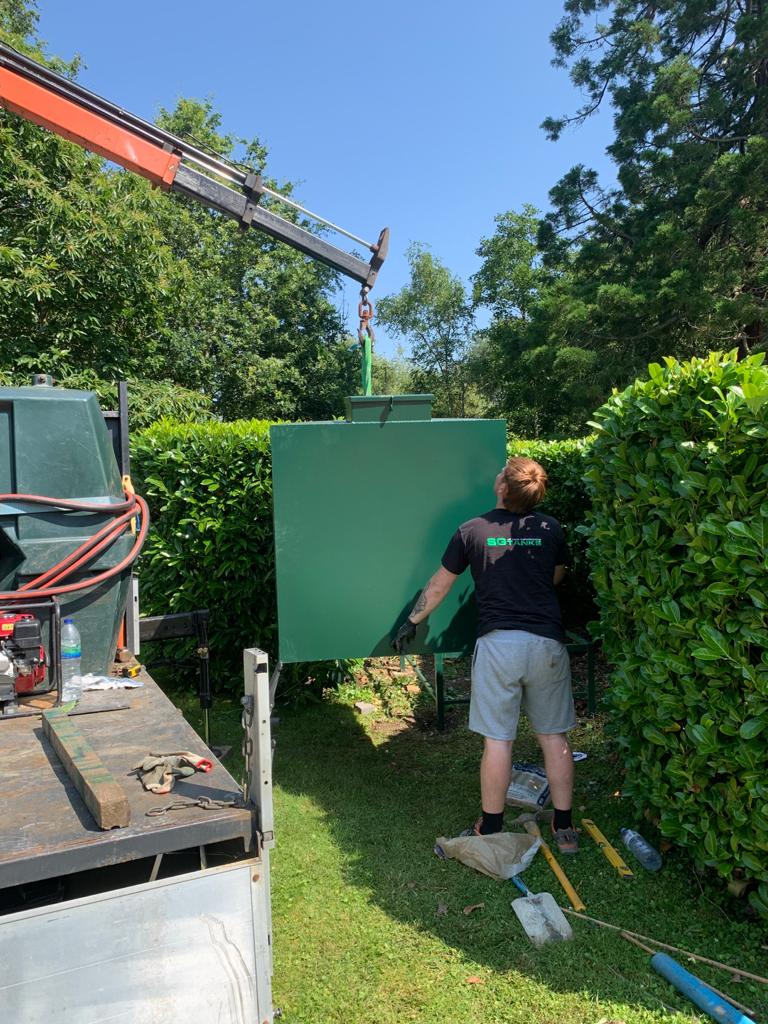As a leading oil tank supplier and installer with over 25 years of experience, SG Tanks understands the importance of properly maintaining your domestic, commercial, or agricultural oil storage.
While regular oil tank servicing and repairs can prolong its lifespan, there comes a point when an oil tank replacement is the only option. Frankly, when this happens, it can often be a welcome change.

However, it’s important to not wait until you have an emergency leak or contamination to the point where your oil tank stops working entirely, or you are left with no heating option at all. By being proactive about inspecting your oil tank regularly and tracking its performance, you can prevent any costly damage before it’s too late.
Keep an eye out for these five key warning signs that will tell you it’s time to consider replacing your oil tank.
What is the Expected Lifespan of a Domestic Oil Tank?
Firstly, it’s important to address a key question of how long an oil tank should, theoretically, last.
On average, a quality domestic oil tank that is professionally installed and regularly serviced should last between 20-25 years. However, lifespan can vary quite a bit based on a few key factors like tank location, exposure to the elements, corrosion resistance, frequency of servicing and others. Steel oil tanks, for example, generally last longer than plastic oil tanks, but that is not to suggest that plastic tanks can’t withstand long periods, particularly if reinforced with corrosion-resistant polyethylene.
Tanks exposed to inclement weather (nothing new for UK residents) without proper enclosures or protection may degrade faster than those installed indoors. Professional oil tank installations with proper foundations and fittings will likely last longer than tanks which are not regularly treated to annual inspections, maintenance, and servicing.
Provided you commit to regular oil tank maintenance, high-grade single or double-skinned oil tanks can last even longer. However, the older it gets, the closer you should inspect it to assess its condition.
5 Signs Your Oil Tank Needs Replacing
If you spot any of the below warning signs, you may need to consider investing in a replacement steel or plastic oil tank sooner rather than later.
1) Visible Tank Corrosion and Rust
One of the most obvious red flags is visible rust and corrosion on the exterior of your metal oil tank. While a bit of surface wear is normal with age, extensive flaking, pitting, and rust suggest advanced degradation. As corrosion perforates the metal, you risk cracks, pinhole leaks and even potential internal tank failure.
Our team routinely inspects for advanced corrosion during maintenance checks and can advise if a new oil tank installation is the safest choice. If your tank can be repaired, we will endeavour to do so, but sometimes rust may be too severe to warrant it.
2) Dents, Gouges or Other Damage
Major dents, gouges, scrapes, or other external surface damage compromise the structural stability of a metal or plastic tank over time. Vehicles, fallen debris and similar heavy duty impacts can warp the tank shell or cause deep fractures and indentations.
Any notable dents or defects are a warning sign to investigate further or consider replacement. You can’t be too careful if a major dent has damaged something inside the tank that could affect or disrupt its runtime.
3) Leaking Oil or Contamination
You should never ignore signs of leaking oil, such as visible oil sheen on your tank or nearby surfaces. Even terribly slow seeps indicate an escalating problem, so do not overlook these.
Leaks that continue unaddressed can pose a serious environmental risk and often result in large upfront cleanup costs, not to mention aesthetic damage to the tank’s enclosure, foundations, and surrounding area. Depending on the severity of the leak, the tank may be repairable, but sometimes it’s far more efficient to arrange a replacement.
Our oil tank installers follow all environmental regulations for safe removal and disposal and will advise which is the safest and most cost-effective option for you.
4) Advanced Age
While they can last several decades if very well-maintained, most modern oil tanks have a functional lifespan of around 20-25 years, or thereabouts.
Older tanks are increasingly prone to corrosion, fatigue and problems if not treated with the proper maintenance and upkeep that they need to continue working. We recommend carefully inspecting any tanks over 25 years old, as replacement often makes better economic sense than more repairs.
Our team can assess tank age and condition during servicing to advise if an oil tank replacement is warranted.
5) Outdated Single Skin Design
Single-skinned oil tanks can still work to a high standard, but these tanks are more likely to need replacing sooner than double-skinned tanks due to the single layer of protection. New tank installations will be reinforced with interstitial leak monitoring for additional safety.
While still legal, some properties still have older single-skinned tanks embedded, but these tanks don’t have the same advanced level of leak and contamination detection. Therefore, upgrading to newer models or opting for a stronger double-skinned tank in favour of an older single-skinned one is strongly recommended. Again, it depends on the status of the tank during its annual inspection.
Is it Best to Repair an Oil Tank or Replace an Oil Tank?
Once an oil tank shows signs of severe wear, or once it begins to experience extended periods of fluctuating performance, homeowners must decide whether to replace or repair their oil tank.
Patching small holes and replacing small fittings are cheaper in the short term and can give the oil tank an extra few years of operation. However, these may not permanently fix issues. New tanks provide peace of mind and avoid makeshift repairs, despite the higher upfront costs.
Consider the extent of the damage, the age of the tank, its location, any environmental factors, and risks. Repairs may make sense for certain problems but replacing tanks may be the only option if damage or risk is too high. Your appointed oil tank technician will be able to advise accordingly during your next routine inspection.
Professional Oil Tank Advice from Local Experts
At SG Tanks, we specialise in removing outdated old tanks and expertly installing suitable new replacements, whether domestic or commercial. We handle everything including permits and proper disposal. Avoid potential problems and schedule a free quote today to discuss your oil tank solution needs.
With over 25 years of proudly serving customers across Hampshire, Surrey, Sussex and the South East, you can trust SG Tanks for reliable advice and quality oil tank solutions.

